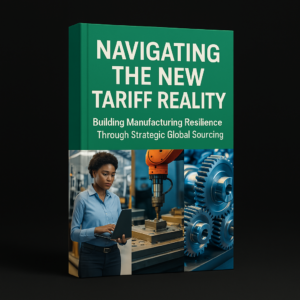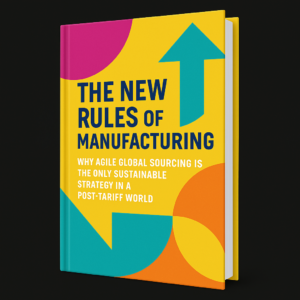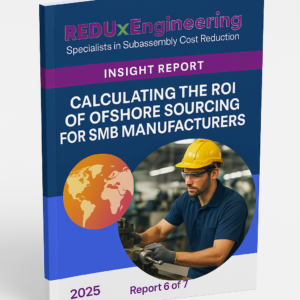
The global trade landscape has been upended by sweeping tariff policies, leaving manufacturers scrambling to adapt to rising costs, disrupted supply chains, and uncertain market dynamics. For tech and hardgoods manufacturers, particularly those operating in the United States or exporting to US markets, the stakes are high. The question is no longer whether tariffs will shape the future of manufacturing—it’s how businesses can adapt to thrive in this new reality.
The Current Tariff Landscape: A Turning Point for Global Trade
Recent tariff escalations have created seismic shifts in global trade. On April 2, 2025, President Trump announced sweeping universal tariffs of 10%, reciprocal tariffs of up to 34%, and a targeted 25% tariff on imported vehicles and parts. These measures are already impacting supply chains, with the Institute of Supply Management’s (ISM) manufacturing index falling into contraction territory at 49.0 in March 20252.
The effects are far-reaching:
-
US manufacturers face rising costs due to higher domestic labor rates and limited contract manufacturing capacity1.
-
International exporters to the US struggle with tariff mitigation, seeking ways to maintain competitiveness4.
-
Global supply chains are under strain, as retaliatory tariffs from China and other nations exacerbate disruptions2.
Jay Timmons, President of the National Association of Manufacturers, warns: “The high costs of new tariffs threaten investment, jobs, supply chains, and America’s ability to outcompete other nations.” Meanwhile, Dr. Elizabeth Morgan from Harvard University emphasizes that “rigid supply chains optimized for cost efficiency are ill-equipped to handle this level of disruption.”
Key Challenges Facing Manufacturers
Manufacturers now face several critical challenges:
-
Over-reliance on China: Companies that sole-sourced production in China are grappling with tariffs exceeding 145%, forcing them to explore alternative regions like Vietnam and India1.
-
Domestic capacity constraints: Onshoring efforts are straining limited US manufacturing capacity, driving up costs and extending lead times12.
-
Retaliatory tariffs: US-based manufacturers exporting internationally face reciprocal tariffs that erode their competitiveness in foreign markets2.
-
Cost pressures: Labor costs in the US are 4-11 times higher than in offshore locations like Vietnam and India, making domestic production economically challenging1.
Dr. Michael Porter from Harvard Business School notes that “the rush to onshore is creating inflationary pressure in domestic manufacturing,” while Carla DeSantis from PwC advocates for a holistic approach: “Successful businesses should not make critical supply chain decisions based solely on tariffs.”
Strategic Solutions for Manufacturers
To navigate these challenges, manufacturers need agile strategies that balance cost efficiency with resilience:
1. Diversify Global Sourcing
Manufacturers must move away from over-concentration in high-tariff regions like China. Vietnam and India offer competitive alternatives with labor rates as low as $6-$7 per hour compared to $77-$115 per hour in the US1. Diversifying sourcing across multiple regions reduces exposure to tariff volatility while maintaining cost advantages.
2. Optimize Assembly Locations
By sourcing subassemblies offshore (under 49% of total value) and performing final assembly in lower-tariff regions (10%-20%), manufacturers can minimize tariff impacts while maintaining competitive pricing for US markets4.
3. Protect International Market Access
US manufacturers exporting globally should establish offshore production facilities capable of drop-shipping directly to international customers. This strategy avoids retaliatory tariffs while maintaining cost competitiveness abroad2.
4. Invest in Resilient Supply Chains
Digitization is transforming global sourcing by enabling real-time visibility into supply chains through blockchain technology and digital procurement platforms3. These tools enhance transparency and coordination, making it easier to adapt quickly to changing trade policies.
5. Leverage Strategic Partnerships
REDUxEngineering provides contingency-based managed offshore sourcing solutions tailored to these challenges. Their pre-vetted global manufacturing network ensures supply chain agility without burdening internal vendor qualification processes. By engineering costs out of subassemblies upfront, REDUxEngineering helps clients achieve savings of 20%-50% while maintaining high quality standards.
REDUxEngineering: A Proven Partner for Manufacturing Resilience
REDUxEngineering’s approach addresses key pain points for manufacturers:
-
Pre-vetted global network: Access a diverse pool of advanced Industry 4.0 facilities across Asia-Pacific, ensuring immediate sourcing flexibility.
-
Cost optimization: Design for manufacturing principles reduce costs by up to 50%, enhancing profitability even under tariff pressures.
-
Contingency-based model: No upfront fees—REDUxEngineering earns only when savings are realized.
-
Quality assurance: Rigorous inspection processes ensure parts meet specifications before leaving factories.
Case studies demonstrate the impact:
-
A CNC machining project reduced per-unit costs by over 50%, generating $105,000 annual savings.
-
An injection molding project achieved a 78% cost reduction ($240 to $52 per unit), saving $1.5 million annually.
-
A PCBA project cut costs by 24%, delivering $1.6 million annual savings.
These results highlight REDUxEngineering’s ability to deliver tangible value for manufacturers navigating complex trade environments.
Long-Term Strategies for Competitive Advantage
Looking beyond immediate tariff mitigation, manufacturers should adopt long-term strategies:
-
Build multi-regional manufacturing capabilities for genuine optionality.
-
Redesign products for manufacturing flexibility across diverse regions.
-
Develop international market diversification plans to reduce reliance on any single market.
-
Invest in digital tools for enhanced supply chain visibility and analytics.
-
Partner with experts like REDUxEngineering for ongoing optimization.
Dr. Sarah Johnson from MIT Sloan School advises: “Companies that create multi-regional capabilities gain strategic optionality that provides advantages regardless of how trade policies evolve.”
Conclusion: Thriving Amidst Tariff Turmoil
The genie is out of the bottle—the era of predictable global trade is over. However, this disruption creates opportunities for manufacturers willing to adapt strategically. By diversifying sourcing networks, optimizing assembly locations, protecting international market access, and leveraging expert partnerships like REDUxEngineering, companies can emerge stronger, more profitable, and more nimble.
As Dr. Robert Chen from Stanford University explains: “The old model of optimizing solely for cost efficiency has given way to a balanced approach that prioritizes both cost and resilience.” Manufacturers who embrace this balanced approach will not only survive but thrive amidst ongoing trade volatility.
REDUxEngineering stands ready to support tech and hardgoods manufacturers with innovative solutions that deliver supply stability, vendor agility, high quality, and lower costs—on-time, every time.
Let’s discuss how your organization can turn today’s challenges into tomorrow’s competitive advantage!
Bibliography
Industry and Economic Analysis
-
Timmons, Jay. National Association of Manufacturers: Statements on the impact of tariffs on US manufacturing competitiveness.
-
Morgan, Elizabeth. Harvard University: Insights into supply chain rigidity and the need for diversification.
-
Porter, Michael. Harvard Business School: Commentary on inflationary pressures in domestic manufacturing due to onshoring efforts.
-
Johnson, Sarah. MIT Sloan School of Business: Recommendations on building multi-regional manufacturing capabilities for resilience.
Labor and Cost Comparisons
-
Bureau of Labor Statistics (2025). Employment Situation News Release: Data on average hourly rates for production and nonsupervisory employees in the United States.
-
The Numbers Don’t Lie: Long Live Offshore Sourcing! (2025). REDUxEngineering Internal Report: Comparative analysis of labor costs between the US, China, India, and Vietnam.
Global Manufacturing Infrastructure
-
Apple Inc. (2025). Apple Newsroom: Announcement of $500 billion investment in US manufacturing infrastructure over four years.
-
KPMG Global Supply Chain Survey (2025). KPMG: Findings on vulnerabilities in global supply chains and increased investment in supplier diversification.
Tariff Policy and Trade Relations
-
White House (April 2, 2025). Rose Garden Tariff Announcement: Details of universal tariffs, reciprocal tariffs, and targeted tariffs on imported vehicles and parts.
-
Macklem, Tiff. Bank of Canada: Economic consequences of prolonged trade conflicts.
-
Rodriguez, Maria. McKinsey & Company: Analysis of tariff-insulated cost strategies for manufacturers.
Offshore Sourcing Opportunities
-
REDUxEngineering Case Studies (2025). Internal examples of cost savings achieved through offshore sourcing strategies.
-
Chen, Robert. Stanford University: Observations on the shift from cost efficiency to balanced supply chain strategies.
Historical Context
-
Historical Manufacturing Trends (1980–2025). Analysis of China’s relentless investment in Industry 4.0 facilities and Vietnam’s recent advancements in electronics manufacturing infrastructure.
Future Projections
-
DeSantis, Carla. PwC: Holistic approaches to supply chain decision-making beyond tariff considerations.
-
Wilson, James. Former US Commerce Secretary: Commentary on structural shifts in global trade.





